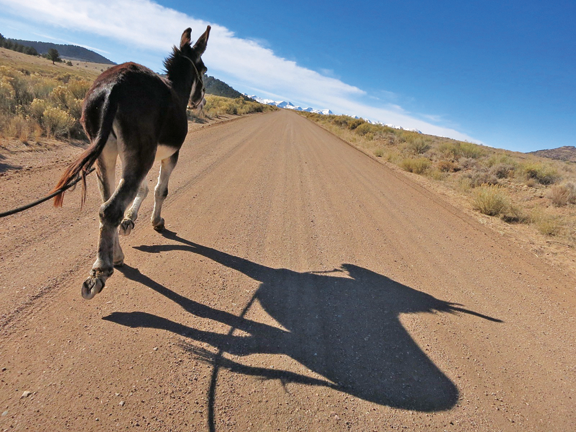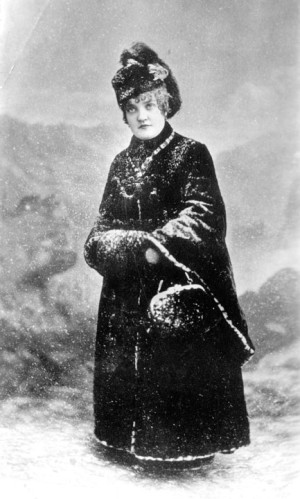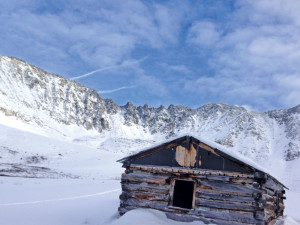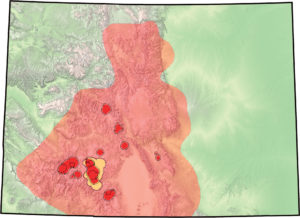The scene reminded me of something out of Road Warrior, a fenced-off section of sagebrush and desolation in the southern San Luis Valley, and behind the closed gate was a veritable junkyard of car and truck bodies, old camper trailers, ramshackle structures, various heaps of well-pipe casings, cement blocks and other scrap.
The sign at the gate got my attention.
“WARNING. TRESPASSERS WILL BE SHOT. SURVIVORS WILL BE SHOT AGAIN.”
Somewhere in this tangled mass of one man’s treasures was a jack donkey/burro I’d driven three hours from the other side of the range to see. In fact, I could detect tall ears sticking up out of the junk.
I’d first seen a picture of this animal on Craigslist, and a call to the number listed began a conversation that went on for several phone calls, as I tried to get more information about the animals for sale and when and how I could see them in person.

The owner explained that he was a truck driver and was on the road a lot with no set schedule. He had a neighbor feeding and watering while he was gone. I explained that I also had a busy and hectic schedule. In fact, this discussion about how I might view his animals – and in particular a 7-year-old jack named Teddy – would go on for weeks. During this time I would learn that he had acquired his first breeding stock, two jennies, from my longtime friend and pack-burro racing mentor Curtis Imrie.
Curtis, of course, is the most innovative donkey breeder in the country, the only one I know who has focused on mixing the naturally selected traits of wild burro stock with the genetics of domestic mammoth and large-standard donkeys. Just about every animal I’d found success with in the sport of pack-burro racing had come out of his program.
I was on the lookout for a new burro following the loss of a couple of animals in the last couple years. Redbo, my youngest donk, died after going blind and descending into a downward spiral of confusion. Then Spike, my oldest, also developed a bizarre neurological problem and died this past spring. Losing Spike was particularly hard on me because I’d won my first world championship with him back in 1998, and then three more. He’d also in recent years helped to introduce some runners to the sport.
The similarities between both Spike and Redbo’s deaths did not escape me – both had neurological problems that no vet was able to explain. I wondered if there was a toxic plant in the pasture, or something in the water. Still, common sense told me I’ve owned and boarded numerous donkeys and horses on this place for 24 years and only lost two in all that time. Now I was down to just one aging burro, Laredo, who has lived here 10 years, and he seemed to be doing just fine. Maybe it was just Redbo and Spike’s time.
In the last couple seasons I’d been training and racing Curtis’ burros, winning a seventh world championship with Full Tilt Boogie in 2013 at the age of 53. As the animal loss began to mount up, I wondered if I really had it in me to train another burro in this lifetime. I halfheartedly looked at ads and checked into possible adoptions but never really saw the animal I was looking for. I’d begun to wonder if maybe he didn’t really exist.
I called Curtis and asked if he remembered selling some jennies to a guy in the San Luis Valley. At first he couldn’t remember it at all. I got ahold of the trucker on the road again, and he was able to provide the names of the jennies, and more information that he had traded a wagon to Curtis for them.
With this, Curtis was able to piece it back together.
When I had first started out in pack-burro racing, Curtis loaned me a jack named Moose, who may be on record as the largest wild burro ever captured. Moose was never a great racer, but he would go on to sire one of the best racing burros in the sport, one named Oscar with whom Curtis won two world championships. Oscar then fathered a donk named Peckinpah, who proved very successful on the racing circuit and in the show ring, and Spike.
I’d brought my car down to look at this burro to save on fuel, and also because if you bring a truck and trailer to look at any livestock, you’re more likely to make an impulsive decision. I sat there contemplating the sign. I was pretty sure I had the right place, but it wasn’t worth getting shot over. I picked up the phone and called the guy, hoping he was inside one of the sheds or camp trailers. He answered and explained that he’d been called away to pick up a load. Just go on in and take a look, he said.
So I wandered through the gate and the maze of scrap, watching not to step on piles of nails that were scattered about. What I found, standing in a small corral of twisted metal panels, well-pipe casings, plywood, galvanized sheet metal and baling twine, was a great-grandson of Moose, a Peckinpah son and a nephew to Spike.
It seemed as if everything had come full-circle. I looked up at Mount Blanca towering above it all, the Great Sand Dunes in the distance, and the Crestones beyond that. On the other side of all that rock and ice was my truck and trailer.
There really was no question. I would have to come back with the rig.
Hal Walter’s new short ebook “Endurance” is now available on amazon.com.






Another great bit of writing Hal! Wishing you a successful racing career with the new jack.
We are in the process of buying a place in Westcliffe and will move up there over the next year. Looking forward to seeing more of you, Mary, Harrison and your donks!
We worked with a realtor from Buena Vista for our search (as we started in BV and worked our way south). After some tramping around various patches of land we chatted about what we would use it for. Burros came up, of course, and it turned out that Oscar had retired at the realtor’s place as a pet in his final years. It’s a small and beautiful donkey world.